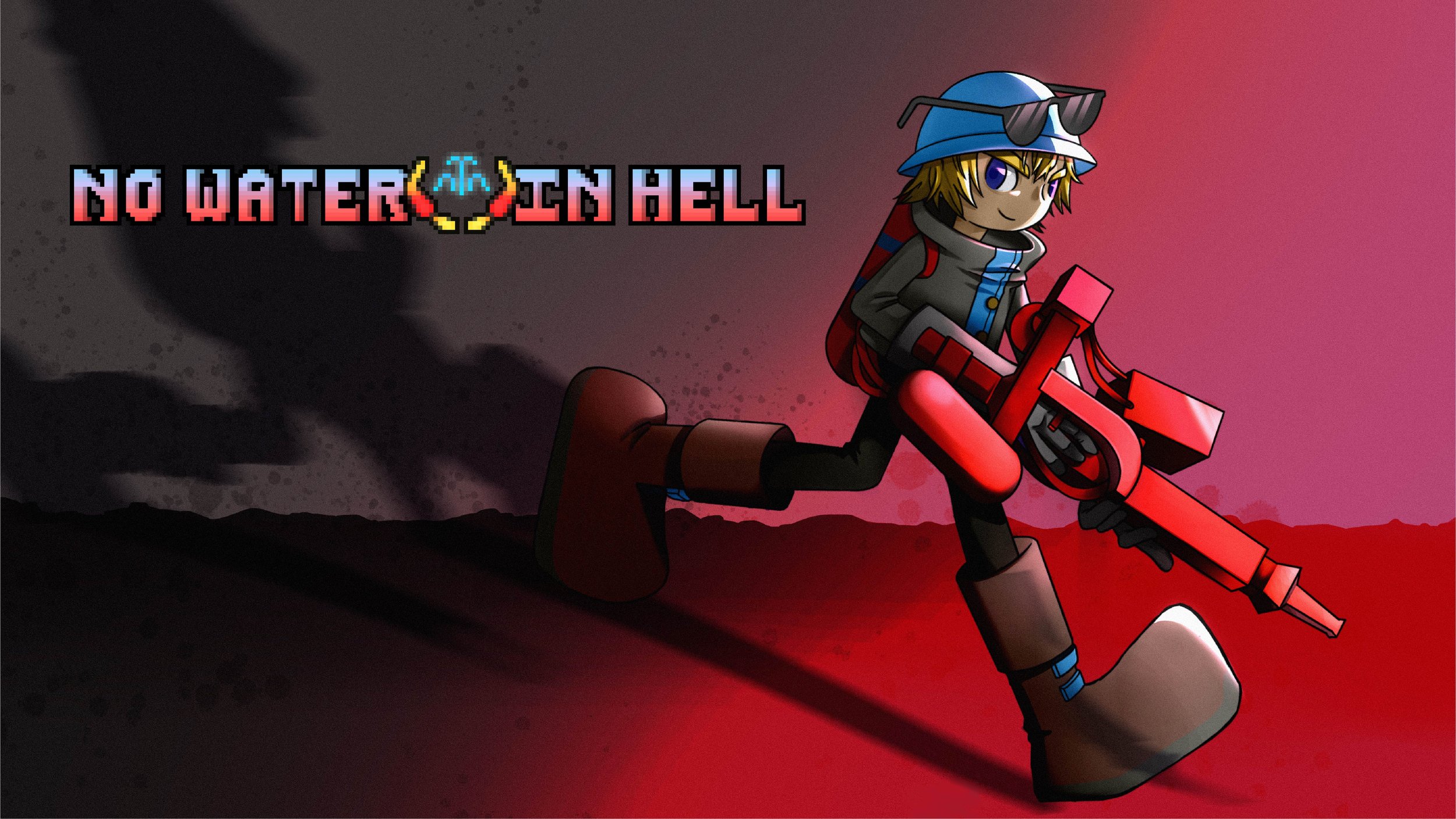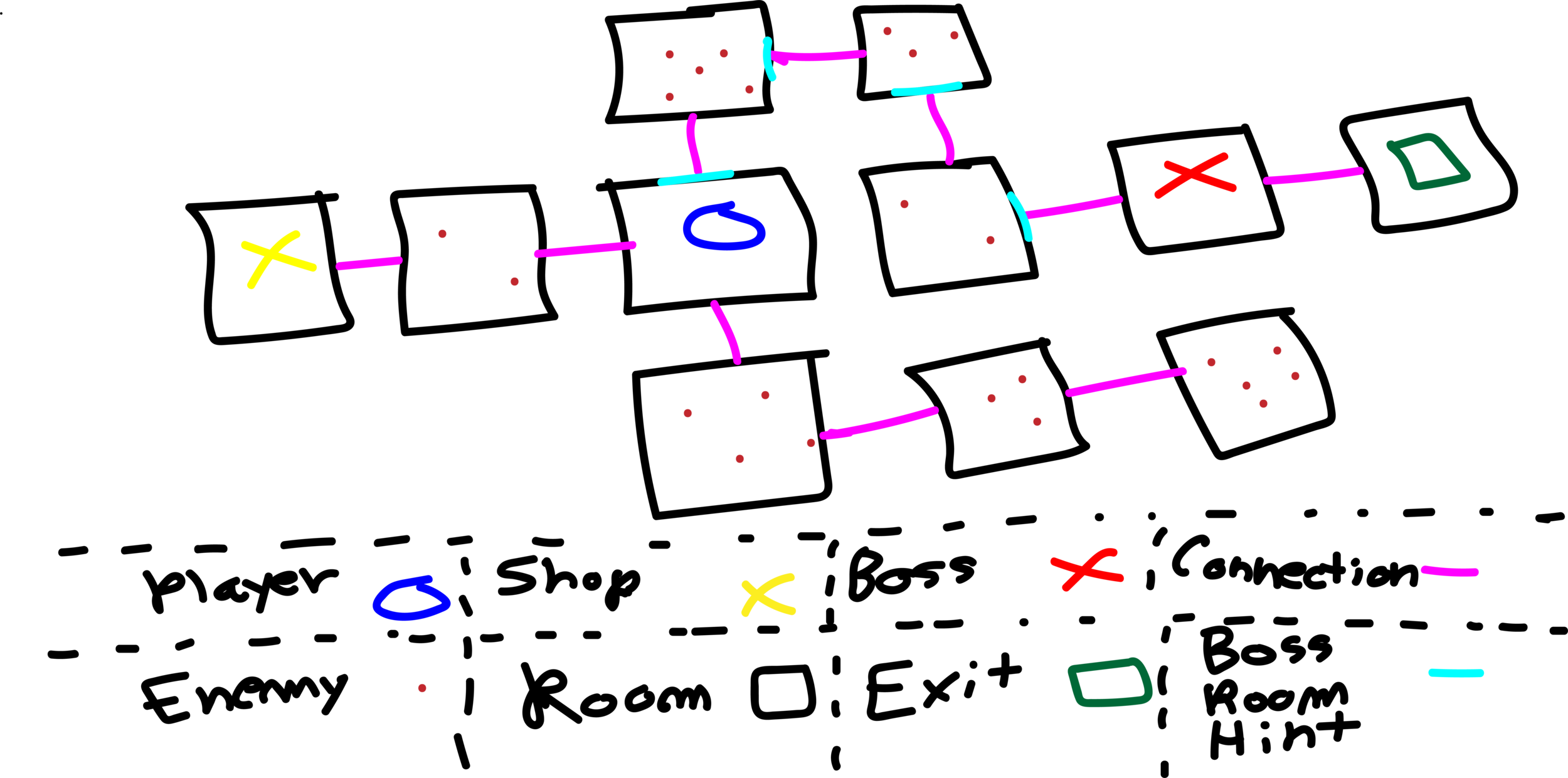No Water in Hell
Standalone long-term Unity Published Project

No Water in Hell is a 2D action-adventure roguelike game in which players run through hell and spray down demons with a firehose.
Not even Hell Will keep You Down.
Players fight through multiplayer floors of hell, inspired by Dante’s Inferno with cartoon/arcade spins on existing ideas. A wide range of items, weapons, music, levels, and enemies await players bold enough to take on this roguelike experience, available on Steam, June 2022.
Level Design
No Water in Hell was built off of many of the same principles in other successful roguelike titles. Player success should be limited and grow due to skill over time as a result of mastery, resources, and partially to luck. To achieve this, we borrowed the idea of a procedurally generated floor system from other titles like HADES and Binding of Isaac. While each game displays varying levels of information regarding the current floor at large, they each provide players with randomly selected options to explore and improve or salvage their current situation from.
We also planned a general flow diagram between each floor of the game. Given it was based upon Dante’s Inferno largely for environment inspiration, we were able to theme our floors (“circles”) around a given sin, and thus tailor the enemies which showed up in each area around these themes. Similarly, we also were able to propose a series of biomes which progressed from region to region of the Underworld. This second idea changed quite a bit through development, starting initially as four biomes (Stone, Obsidian, Lava, and Ice) to eventually develop into 10 biomes (Stone, Cove, Swamp, Volcano, Desert, Ice, Flesh, Golden, Obsidian, and Wasteland). This series of changes was due to our team wanting to push a level of creative liberty onto the subject matter which we often felt quite serious for the course of a video game, and due to the bosses we developed and placed in these areas.
There were other areas of focus I addressed as well, but for simplicity sake, these included:
Designing items, moving hazards, roughly 30 unique enemies, and 10 bosses.
Rapid drafting of 75+ unique room templates for review.
Keeping the team up to date with the latest documentation (LDDs, Flow Charts, Diagrams, etc.) to align with current project goals.
Hosting playtesting sessions and encouraging discourse and feedback from team members and players alike.
A quick visual mockup of the ideas of each floor. A boss room should always be present to serve as the most significant challenge to a player on a floor, which guards the exit from that floor. The player should ideally spawn somewhere in the center of the floor to gain agency over their choices and challenges. Each room has a chance of spawning a varying number of randomly selected enemies, depending on the room template. Shops will spawn with no enemies as they offer players an opportunity to safely change their strategies. All rooms have connections to other rooms, and the closest path from the player to the boss room is signified with a visual hint at the door which leads to the boss room, as a way of nudging the player along the main path of play.
Our bosses made us rethink our organization structure of the existing and upcoming floors several times over. We made sure to include an entity at nearly every turn we could (with a couple exceptions) from varying religions to play on the narrative theme of Hell being shared by various beings of death. Perhaps the Underworld was a place not exclusive to only Greek entities, nor was it a Hell of some kind exclusive to Christian monsters and demons? To portray this cohesively, we turned each floor into a unique biome as its own slice of the Underworld with its own guardian from a different religion. One example can be found below.
Charon occupies the Cove biome as his place in Greek religion has him ferrying souls into the Underworld on behalf of Hades. He uses the River Styx to navigate each way and is said to be nothing more than a ferryman. However, we quite liked the interpretation from HADES which gives him some of the most powerful and frightening attacks in the game. His theming around the cove biome also led to some interesting ideas being proposed: a siren enemy was designed around this, water was added to the game, and Charon was the first boss designed with water themed attacks and a multi-component hitbox for use during his boss fight given he is technically composed of the ship and himself.
Some of the tools I used for this include…

Adobe Illustrator, used for rapid level drafting

Unity, used for implementation

Office suite, used for organization, presentation, and collaboration on ideas. Also used to itemize level metrics and requirements.

Trello, used for project management.

Github, used for version control.

Miro, used for visual flow diagrams and collaboration.
Some of the other roles I also filled…
-

Systems Design
The economy and combat systems changed nearly every week, meaning the entire team needed to be able to quickly map changes.
-

Sound Design & Music
The wrong track is identical to the right track, but ramps up the distortion and ‘character’ settings to create entropy and signal to players this version of music is not the goal.
-

Project Management
Keeping an ever-changing team on task and on time posed its own challenges, but was manageable through a variety of strategies.
-

Narrative Design
No Water in Hell required an emphasis on lore with snippets of dialogue to explain world events and circumstances.



